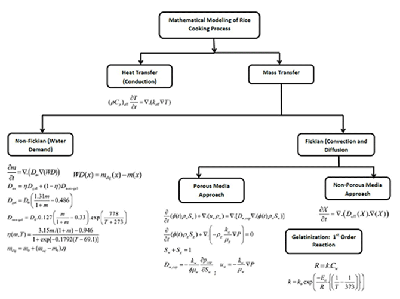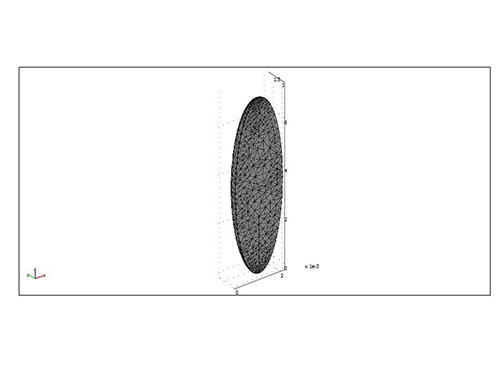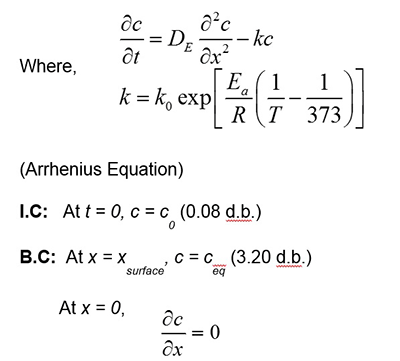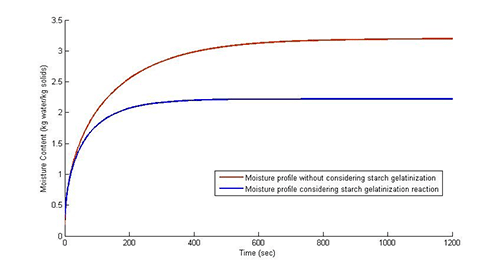18 May 2012
Every year the Seligman APV trust invites graduates or postgraduates or equivalents with food engineering background to pursue Seligman APV Award in the UK’s renowned research centres. I am very grateful to SCI Seligman APV committee to give me an opportunity to take up this award. I am the sixth Indian recipient of this award.
To pursue this fellowship, I landed in Birmingham on 6 May 2011 and joined the University of Birmingham as a student visitor. I used this visit from 6 May to 3 September 2011 to investigate modelling of rice cooking process using finite elements using COMSOL Multiphysics 3.5a (Burlington, MA, USA) under close supervision of Dr Serafim Bakalis (Chemical Engineering Department, University of Birmingham). Apart from pursuing a research project, I used this opportunity to visit relevant industries and research centres.
Research Project
Rice is the seed of a monocot plant Oryza sativa, of the grass family (Poaceae). As a cereal grain, rice is probably the most important grain with regards to human nutrition and caloric intake, providing more than one fifth of the calories consumed worldwide by the human species.
Rice is cooked by boiling or steaming, and absorbs water during cooking. It can be cooked in just as much water as it absorbs (the absorption method), or in a large quantity of water which is drained before serving (the rapid-boil method). Mathematical modelling and simulation of the cooking process play an important role in designing and optimising the cooking process.
Project Objectives
- Familiarity with the Finite Element Software COMSOL Multiphysics 3.5a by solving Heat and Mass transfer equations and comparing the numerical results with analytical solutions for simple geometries
- Thorough understanding of rice cooking phenomena
- Survey of Mathematical Models available in literature for rice cooking process
- Mathematical modelling of rice cooking process using COMSOL considering 3D Prolate Spheroid Geometry
Rice Cooking Phenomena
The rice cooking phenomena can be summarised as follows:
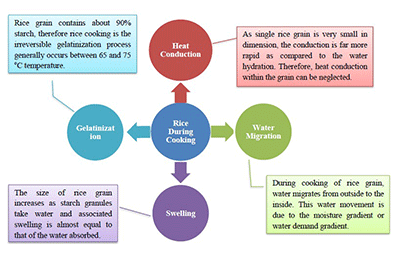
Fig 1: Rice cooking phenomena
Fig 2: Modelling approaches for Rice Cooking Process
Mathematical modelling of rice cooking process
Numerical Simulation: FEM Software COMSOL 3.5a
Diffusion-Reaction Equation:
Fig 3: Meshed Geometry
(Data borrowed from ‘Modelling of rice hydration using finite elements’ Bakalis et al., 2009)
Key Findings
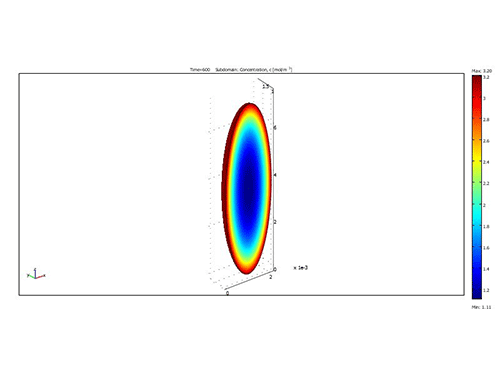
Fig 4: Moisture profile after 600s of rice cooking
Fig 5: Simulated average moisture profile
Figure 4 shows the moisture distribution in the rice grain (assumed a prolate spheroid) after 600 seconds of cooking at a temperature of 100 0C. Figure 5 shows the simulated average moisture profiles with and without considering the effect of gelatinization. As can be seen, the gelatinization increases the amount of water uptake inside the grain. Water as it comes inside the grains reacts with the starch molecules thereby creating more gradient inside the rice grain resulting in more water uptake.
Future Research Work
- Obtaining the value of Reaction Rate Constant, Activation Energy and Effective Diffusivity (Deff) value by minimising the error between predicted and experimental results
- Incorporating the effect of dimension change of rice grains during cooking
- Modelling rice cooking phenomena in a rice cooker – a widely used household appliance
Visits
During this fellowship I visited a number of universities, research institutions and industries. Hosts were cooperative and made all the visits informative and enjoyable.
Following are the places which I visited during the fellowship:
- Prof Keshavan Niranjan, Department of Food Science, University of Reading
Prof Niranjan gave me a short tour to the labs and pilot plant facilities. The discussion during the visit was about effect of pressure and temperature on enzyme activity, application of vacuum on post frying of potato chips and creating stable milk foams.
- Dr Gary Tucker, Campden BRI, Chipping Campden
This visit was about learning how bread, cake and related bakery products are manufactured in large scale facilities. We also had discussions about different types of dough mixers, baking ovens etc.
- Kerryn Leather and Beccy Smith, Kraft Foods, Birmingham
The factory visit was about learning key aspects about the manufacturing process of Cadbury crème egg, Cadbury buttons, Cadbury flakes etc.
- Dr Bettina Wolf, Department of Food Science, Nottingham University
During this visit the main topic of discussion was about the rice starch gelatinization process – to understand the chemistry behind the gelatinization process and the origin of starch stickiness in rice.
- Dr Paul Skudder, SPX Flow Technology, Gatwick
The discussion was focused on the membrane technology and its application to the dairy industry and new innovations in CIP technology such as reuse of caustic soda.
About Swati Kadam
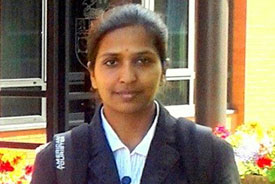
She attended the Dr Balasaheb Sawant Konkan Krishi Vidyapeeth, Dapoli from 2001-2005, to earn a Bachelor’s degree in Agriculture Engineering. Her Bachelor’s thesis was on ‘Design and Analysis of Greenhouse trusses for Konkan Region’. Thereafter, she went on to complete her Master’s Degree in Post-Harvest Process and Food Engineering with a JRF (Junior Research Fellow) scholarship awarded by the Indian Council of Agricultural Research (ICAR) from 2005-2007.
For her Master’s research, she worked on developing jaggery based chocolates – a first of its kind, optimising various process parameters through Intelligent Sensory Evaluation techniques.
After completing her post-graduation, she took up a position as a Food Technologist in Jain Irrigation Systems. Her year long tenure in Jain Irrigation provided her with an exposure to the fascinating field of food processing dynamics and the application of instrumentation in the same. She then discovered a particular interest towards scientific research which prompted her to pursue a PhD.
Later, in 2009 she was admitted as a full-time student to the Indian Institute of Technology Kharagpur, one of the premier institutes of Engineering and Applied Sciences in India to pursue a PhD degree in Dairy and Food Engineering at the Agricultural and Food Engineering Department. Her doctoral studies are focused on the design, development, fabrication and performance analysis of continuous kheer (a form of rice pudding) making machine.
For her work so far, she won the best poster award in the 39th Dairy Industry Conference organised by Indian Dairy Association (IDA). She was invited by the Society of Chemical Industry to pursue the prestigious Seligman Fellowship at the University of Birmingham. Her project involves modelling and simulation of rice cooking process using Finite Elements.
Besides an avid researcher, she is also a chess enthusiast, winning several prizes in inter collegiate competitions. She is also a member of ‘Sahaja Yoga Society (NGO)’ which works over 140 countries. Sahaja Yoga is a solid experience, an actual, physical reality verifiable in one’s own nervous system through meditation, that leads onto spontaneous improvements in one’s well–being and relationship with the world.
Achievements and benefits
The award gave me an opportunity to visit different research groups working in the field of Food Engineering in different universities and organisations in the UK. So it was an excellent opportunity to interact with scientists and researchers working in this field. This visit helped me to enhance my knowledge and learn emerging researchable issues in my field of interest.
Also, working with Dr Serafim Bakalis was a very good opportunity to delve further into the process of rice cooking process. Research work done during this fellowship in the area of modelling of rice cooking process explored new techniques and innovative ideas.
Apart from a good research exposure, this award also gave me cross-cultural experience as I got the opportunity to interact with people here at England and understand the county’s social culture.
Acknowledgements
I would like to thank the SCI Seligman APV Trust and its management committee for selecting me for this prestigious fellowship.
I would like to thank especially, Dr Serafim Bakalis, University of Birmingham, for his constant support and guidance during this fellowship.
I express my heartfelt gratitude to Mr. Graham Byars, Chairman, Seligman APV Trust, Ms. Monica Ugalde, Membership Services Manager, and Ms. Charne Green, Award Coordinator, for their care and personal attention.
I am grateful to the Indian Institute of Technology Kharagpur, India for allowing me to take up this fellowship.
I am also grateful to my family for their constant encouragement and everlasting blessings throughout this fellowship.
Last but not the least my heartfelt gratitude to the Almighty for his enlightenment and benevolence.
Related Links

